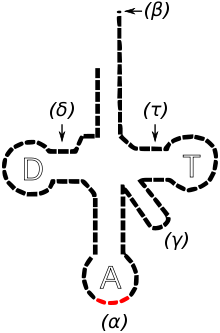T arm
The T-arm or T-loop is a specialized region on the tRNA molecule which acts as a special recognition site for the ribosome to form a tRNA-ribosome complex during protein biosynthesis or translation (biology).
The T-arm has two components to it; the T-stems and the T-loop.
- There are two T-stems of five base pairs each. T-stem 1 is from 49-53 and T-stem 2 is from 61-65.
- The T-loop is also often known as the TΨC arm due to the presence of thymidine, pseudouridine and cytidine residues.
Organisms with T-loop lacking tRNA exhibit a much lower level of aminoacylation and EF-Tu-binding than in organisms which have the native tRNA.
In Mammalian DNA, telomeric repeat-binding factor 2 or TRF2 has been found to remodel linear telomeric DNA into large T-loops.
References
- Griffith JD, Comeau L, Rosenfield S, et al. (May 1999). "Mammalian telomeres end in a large duplex loop". Cell. 97 (4): 503–14. PMID 10338214. doi:10.1016/S0092-8674(00)80760-6.
This article is issued from
Wikipedia.
The text is licensed under Creative Commons - Attribution - Sharealike.
Additional terms may apply for the media files.
